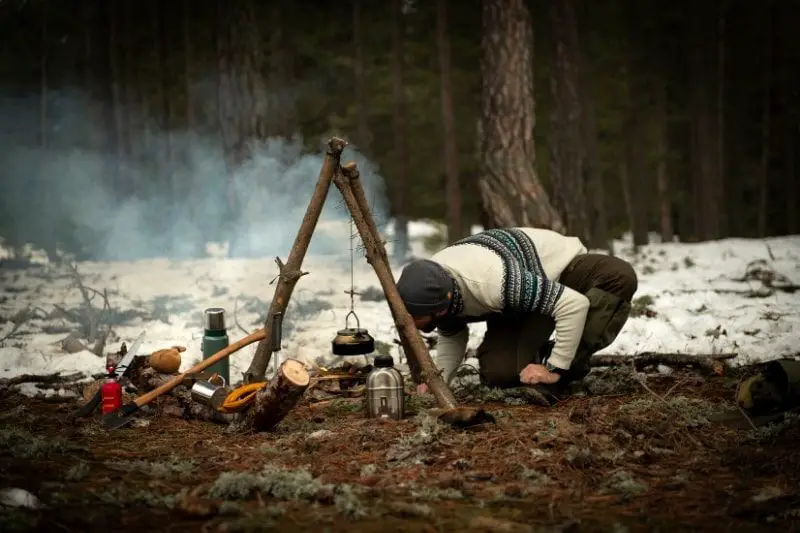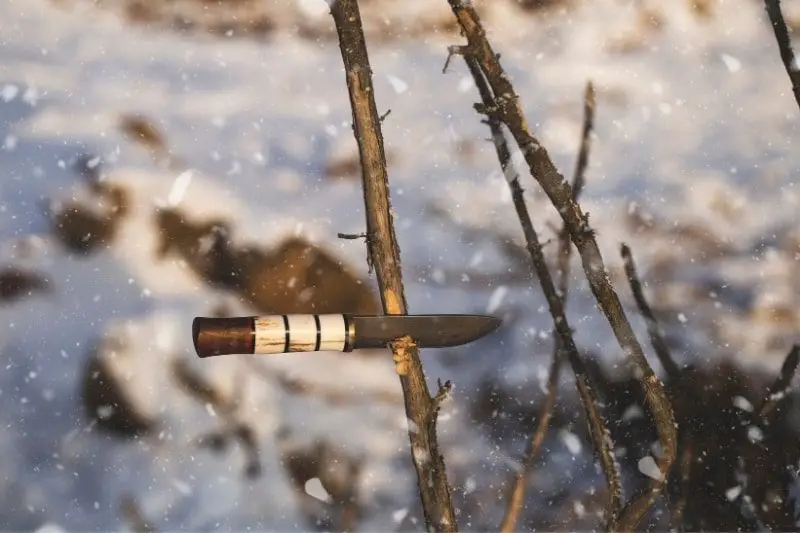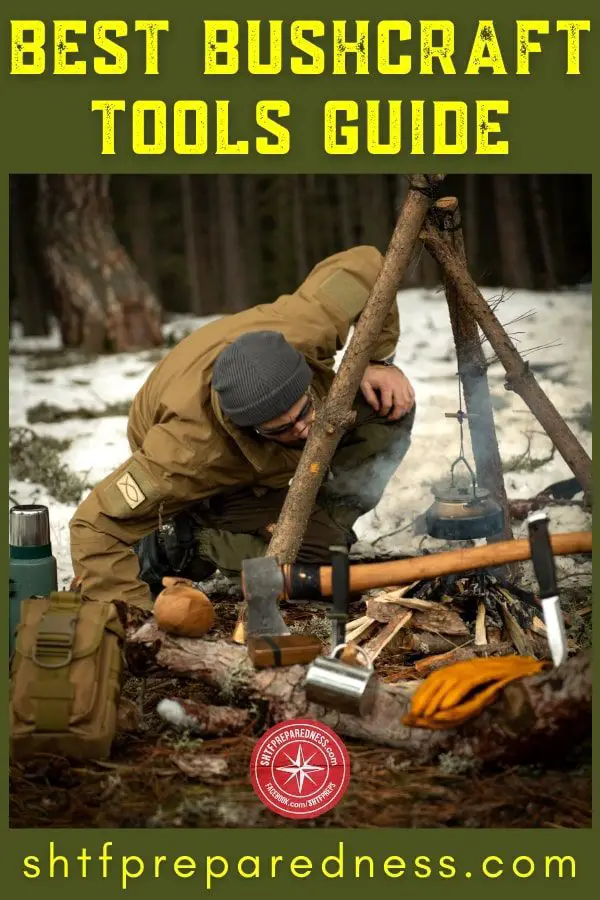SHTFPreparedness may collect a share of sales or other compensation from the links on this page.
If you have decided to delve into bushcraft, you are about to enter a whole new world. Bushcraft skill sets are those that enable you to survive in the great outdoors.
There are two sides to this coin, though: the skills and the tools. This best bushcraft tools guide will get you started with the minimum tools needed to build your skills.
Once you have the basic tools, bushcraft is all about learning and practicing techniques so you can thrive away from modern conveniences.
The more knowledge you have, the longer you’ll be comfortable in nature. Let’s cover the first part of the bushcraft equation: tools!
Bushcraft Tools vs Survival Tools

If you are in an “end of the world” or grid-down situation, you need to survive until you get to safety or safety finds you.
The traditional starting point for getting home or bugging out is three days. Have the tools and mindset to endure 72 hours.
Mindset
You must have the survival mindset to live until you reach a secure location. Your mindset keeps you going despite difficult circumstances and insurmountable odds.
You must also have the proper tools. In this situation, you’ll leverage your 72-hour bag or bug-out bag. The tools you packed inside will help you live to see another day.
If instead, you head out into the wilderness for a few days to commune with nature, you will need bushcraft tools and gear. Your mindset is to enjoy your retreat from the busy outside world.
Your tools help you exist comfortably in the natural world. They provide shelter, heat, and food with minimal expenditure of time and effort.
The distinction between the two isn’t cut and dry, though. A survival situation may include being lost in the wilderness.
You must survive for several days until you reach safety or are rescued. Survival, just like bushcraft, focuses on starting a fire, building a shelter, finding and purifying water, and finding sources of food.
Contrast this with someone developing bushcraft skills. They are building self-reliance in the great outdoors.
Their focus becomes using natural elements and resources to enhance the time you have available to enjoy nature. They develop skills that ancient indigenous peoples all over the world used in everyday life.
What’s the Difference?
The difference is between sustaining life and skills that allow thriving in the wild. The survival tools are lightweight, high-tech, and not made to last long.
Think of a light pack, decent multi-tools, a good lighter, waterproof matches, fire-starting materials, canned food, a water bottle with a filter, a compass, and a mylar poncho to stave off the cold.
Contrast this with bushcraft tools made to endure. Think a heavy-duty backpack, a good hatchet, at least 2 different knives, seasoning for the fish you will catch, fishing gear, flint for fire starting (with a backup lighter), and good layered clothing.
How Do You Know What Tools Are Essential for Bushcraft?
If you are planning a bushcraft retreat, you probably have a location already established. You know which skills you want to work on. Perhaps this week it’s catching game.
Bring the tools necessary to set up camp, build a shelter, start a fire, set up snare traps, and catch fish. You aren’t bringing high-dollar fishing gear; you are bringing a good fishing line, hooks, a homemade bobber, and something for bait.
Put together a list of the bushcraft tools you need to develop the skills to allow you to live well in the natural environment.
What Gear Do Bushcraft Experts Consider “Cheating”?
Some bushcraft experts believe that getting back to primitive tools is more in tune with the reasons behind living in the wilderness. Creating your tools from whatever is at hand is an admirable goal.
Here are a few tools you can make by hand:
- Primitive spears are used to take down game and fish
- Bow drill for starting a fire
- Slingshot for small game
- Rope or twine made from plant material at hand
Some bushcraft purists believe that anything beyond a couple of good basic knives is ‘cheating’. With bushcraft knives and the appropriate skills, you can build a shelter, start a fire, catch game, and cook it.
Some tools they may consider cheating include:
- Lighters and waterproof matches
- Nylon tarp
- Hatchets, axes, and handsaws
- Everything else
For a true bushcraft purist, traveling into the wild with a veritable treasure trove of gear is cheating. Some individuals prefer to head out with their two hands and their survival knowledge.
For these purists, bushcraft means surviving by making primitive tools as they are needed. These individuals may make an axe out of natural materials rather than bringing one along. You do not have to go to this extreme; there are many ways to enjoy bushcraft.
Your journey into bushcraft is just that—your journey. Your end goal is to survive and thrive in the wilderness, and to enjoy doing so.
It is perfectly acceptable to have a variety of bushcraft tools at your disposal to do this. Here’s our list of the best bushcraft gear items we consider essential for your bushcraft tools kit.
Best Bushcraft Tools and Gear
Let’s look at some of the bushcraft tools you might add to your collection of supplies as you learn bushcrafting.
As you gain more experience, you will discard some of your earlier choices as you find better bushcraft tools. That’s just part of honing your craft.
Remember, the more you carry in your head, the less you carry on your back.
Knife

One survival knife won’t do everything you need a knife to do. You’ll need a high-quality knife that can split wood for a fire, dig a hole, and cut rope. You’ll also need one that can perform the detailed tasks of cleaning fish and preparing small game.
Invest in a full tang bushcraft knife. These are much less likely to break off from the handle with rough use. Splurge a little here. Look at the tasks you need to do and don’t be afraid to carry a couple of different knives into the bush.
Whetstone or Knife Sharpener
Your knives must stay sharp to operate at top efficiency. Pack a small whetstone or another type of knife sharpener.
Keep the edges sharp on your knives and other bladed tools. You can use a smooth stone, like those found alongside rivers, if you want to go old-school on this.
Hatchet or Axe
If you are planning to build a shelter, you will want a good survival axe or hatchet. This tool can split wood with ease. It will also prove helpful in cutting wood for your fire and in hammering in tent stakes if you decide to set up a tent.
Remember, part of bushcraft is preserving your calories and energy. It’s much more efficient to process wood with an axe vs a knife.
Fire Starter
Traditional tools for starting a fire include flint and steel or a ferro rod and striker. Both methods require practice. It’s always good to include a lighter and some waterproof matches in your kit, just in case.
Having matches or a lighter as backup is simply good planning. If bushcraft practice suddenly turns into an emergency, always prepare to start a fire in the easiest possible way.
Tinder
If it’s damp in your retreat location, you may need something to use as tinder. Some bushcrafters have cotton balls dipped in Vaseline in their kits. Likewise, others make char cloth to keep with them in case it is needed to start that important fire.
Experiment with the multitude of options found on the internet. Find what works best for you. Both prepared in advance and those made in the field.
Shovel
It’s not glamorous. It’s not exciting. But boy, is it handy to have a shovel?
A good survival shovel serves several important functions, but the most important is to dig a latrine. Burying your waste is safe and hygienic, and you won’t draw wild animals to your camp.
A shovel also allows you to cover that fire with dirt before you leave camp.
Cooking Implements and Canteens
You must purify water before drinking it. Period!
Water purification involves boiling water in a pot or even in a metal canteen before drinking or using it for cooking.
Look for a basic pot or a compact portable cooking set that can be used over your campfire. And remember: you will hike during the day, so a canteen is a great way to carry that life-sustaining water with you.
A single-walled stainless steel water bottle is also a great option. Never use an insulated water bottle. When heated, they can explode.
Cordage
Cordage, like 550 paracord, serves a wide variety of purposes around camp. It suspends your game bag overhead to discourage bears from getting into your food.
Paracord also supports your temporary shelter or hangs up a lantern. Finally, it can lash tools into your backpack.
Need a fishing net? Weave your own on-site with the core strings in paracord. Don’t go without this inexpensive but important bit of gear.
Compass
Bushcraft skills include using the stars to navigate at night, but the use of a quality compass is another bushcraft skill. Find a good book showing the constellations so you can work on recognizing them on those clear nights.
Carry a map of the area with you and use that compass to develop your orienteering skills while you are on your retreat.
Explore Bushcraft Further
Developing bushcraft skills can take a lifetime as you continually develop your skills and expand your knowledge base.
Just remember, bushcraft is inspired by the concept of freedom.
The freedom to travel the backcountry with only your well-worn backpack, confident in your ability to delight in the adventure awaiting you.
